Route 66 is a World-Renowned Landmark
Index to this page
How Route 66 became so famous
Route 66 acquired fame over the years for different reasons. Initially during the late 1920s and 1930s the U.S. 66 Highway Association lobbied intensly to have it numbered with "66" instead of "60", to have it paved along its whole extension, and marketed it as the shortest and fastest route, with the best weather and the nicest attractions between the Midwest and Los Angeles.
During the bleak days of the Depression and the Dustbowl in the 1930s, hundreds of thousands of displaced farmers used Route 66 to seek new jobs and lives in California, many failed and returned along the same highway. John Steinbeck portrayed their plight in his Pulitzer Prize-winning novel The Grapes of Wrath in 1939, and John Ford made an Academy award-winning movie from it in 1940. Millions of Americans saw the Joads drive along Route 66 from Oklahoma to Los Angeles.
During World War II, the highway became a vital snow-free corridor between east and west, hundreds of thousands of young American men moved along it to be trained, transporting ammo or foreign POWs.
After WWII, these same young men, now veterans drove west seeking better jobs in the Sunny Southwest. Bobby Troup made Route 66 a popular name with his 1946 hit "(Get Your Kicks On) Route 66", and that same year, Jack Rittenhouse self-published his famous Guidebook to U.S. Highway 66 for those who wanted to drive it, to find new job openings in the west.
During the prosperous years that followed, families got into their cars and drove west to visit the magic Southwest, Route 66 received them with its neon signs, motels, quirky sights and wacky attractions adding allure to their vacations. Postcards sent back home to friends and family helped build the myth of Route 66.
America's love for cars and freedom soon discovered the boundless opportunities of road trips that were popularized through books like Jack Kerouak's novel "On the Road" (1957).
But at the same time that Route 66 was enjoying its heyday, President Eisenhower created the Interstate Highway system in 1956, the freeways would soon replace the old Route 66.
The television series "Route 66," (1960-64) was already nostalgic in the final days of the Mother Road. In 1964 it was decertified west of Pasadena, by 1972 it no longer existed in California. But its fame survived.
Below we will look into some of these fame-building factors.
Advertising and Promotion
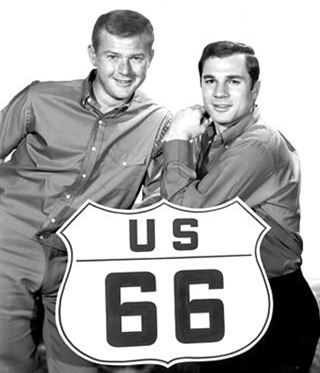
Martin Milner and George Maharis of the early 1960s TV series "Route 66".
In the 1924 the Associated Highways Association of America (AASHO) put forward its proposal for an interstate highway system that in 1926 resulted in the U.S. highway system we have today. A Committee was organized to define the numbering system for the highways and one of its members, Cyrus Avery, from Tulsa Oklahoma secured the magic number "66" for the highway that would link Chicago with Los Angeles.
Cyrus Stevens Avery (1871–1963) was an entrepreneur and oilman who had worked hard promoting good highways; he joined forces with John Thomas Woodruff (1868-1949) a businessman from Springfield MO who had also been a promoter of the Ozarks highways in the early 1900s. Both founded the U.S. Highway 66 Association with Woodruff as its first president.
The goal of the Association was to pave U.S. Highway 66 and to promote it; they understood the potential of interstate travel and commerce and the changes that automobiles would bring to America.
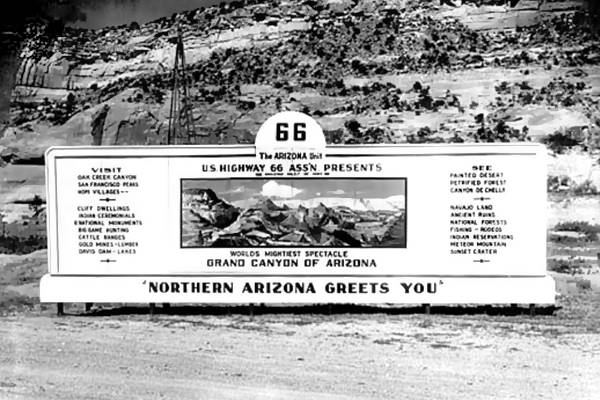
Real paving efforts began in 1926 but would not be completed until 1938.
Avery is known as the "Father of Route 66."
Like the pioneer days, when they outfitted at St. Louis for all points in the West and Southwest, so today people traveling by auto find themselves coming to St. Louis over the various U.S. roads, and when arriving in St. Louis, by consulting their map, find U.S. 66 is the most direct road to the Pacific coast and likewise to all points in the great Southwest.
I challenge anyone to show a road of equal length that traverses more scenery, more agricultural wealth, and more mineral wealth than does U.S. 66 Cyrus Avery Cyrus
In 1935, following the death of legendary actor and star Will Rogers, they changed their name to the Will Rogers Highway Association and renamed U.S. 66 as the Will Rogers Highway.
The Association placed ads in magazines, printed brochures and set up billboards along the highway.
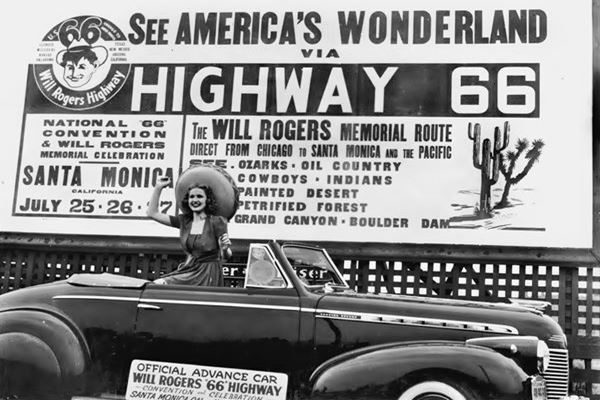
America's Main Street
Avery came up with the name "The Main Street of America" at the Association's first Conference; and it was a hit, evoking local stores lined up along the road catwering to travelers. This was actually a fact because Route 66 was the Main Street in each of the towns it went through.
The Association promoted the highway as the shortest route between the Great Lakes and the Pacific Coast, and also as a scenic route: the Ozark region, the Texas Panhandle and the Grand Canyon in Arizona.
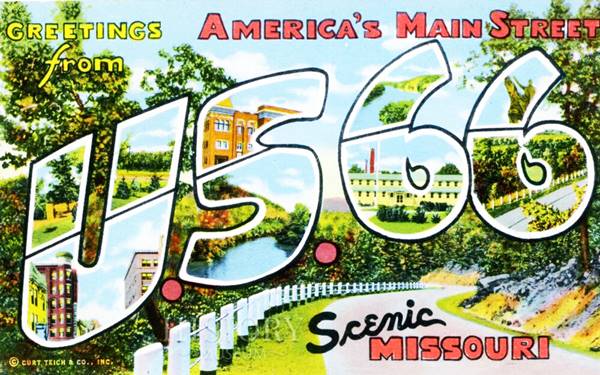
Below is a twelve page brochure published by the National U.S. 66 Highway Association in 1959, in the days of the interstate. It had maps with distances, the main towns, and pictures of the attractions. It boasted:
U.S. Highway 66 is one of the best known highways in the United States, certainly in the West. Movies have been made along it, and books have been written about it. This famous route strikes west and east 2200 miles in a great circle curve (shortest distance on a global surface) between Chicago and Los Angeles. It is the first choice of experienced and informed travelers, who know how to pick the best highway for a long trip…For the best trip across the West, drive U.S. 66 ALL THE WAY. National U.S. 66 Highway Association (1959)
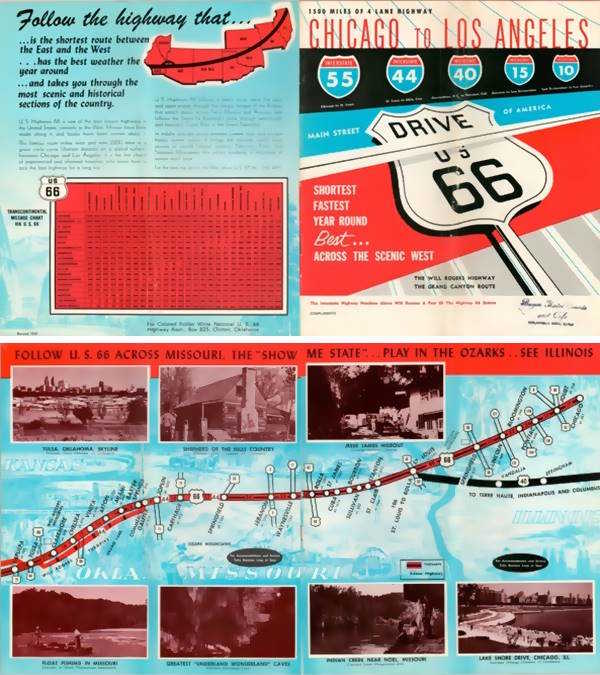
Route 66 in the Culture and Media
[Migrants] come into 66 from the tributary side roads, from the wagon tracks and the rutted country roads. 66 is the mother road, the road of flight John Steinbeck, Grapes of Wrath (1939)
John Steinbeck, who would later win the Nobel Prize in Literature, that coined the name "Mother Road" for Route 66. As a Californian, he experienced the plight of those fleeing from the terrible effects of the Dust Bowl drought, and migrating to California along highway sixtysix. In 1939 he wrote Grapes of Wrath a novel that recorded the suffering of the Joads, a migrant family who lost their farm during the Depression and drought.
Historic Fact
Tens of thousands of families had to abandon their farms in the Midwest as they defaulted their mortgages due to the devastating effect of the Dustbowl drought on their crops combined with Banks closing across the country due to the Great Depression. They had to seek fortune elsewhere.
An estimated 210,000 people took to the road and migrated to California looking for jobs. But the Depression had crippled the whole natation and most of them drove back; only 8% of them remained in the Golden State.
John Ford's Oscar-winning movie based on the book shot scenes along U.S. 66 and viewers across the nation saw it black and white on movie screens; below are two scenes of the Joads' jalopy and Route 66 signs:
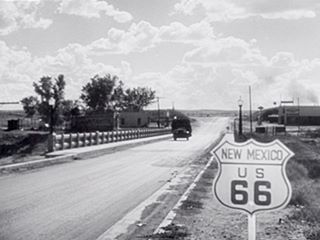
Pecos River Railroad Bridge, Santa Rosa NM.
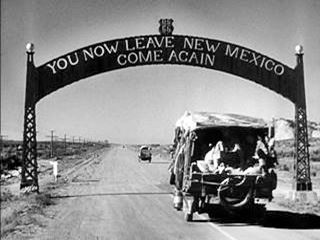
The Gateway Arch at New Mexico - Arizona state line on Route 66
The highway remained etched in the American memory with Route 66 portrayed for those escaping famine and unemployment as the "Road to Opportunity".
> > Learn More about the Grapes of Wrath
The 1940s and 50s had the Southwest as backdrop to dozens of Western movies with cowboys, Indians, pioneers, and the cavalry riding across the Far West. Secenes that charmed viewers with colorful deserts, cacti and wonderful nature.
The hit song "Route Sixty-six" was written by Bobby Troup in 1946 shortly after the end of WWII as he drove across the continent along US66. It was performed by Nat King Cole with its catchy lyrics popularized Route 66 and made it a household name. The song reflects the optimism of a generation that had just come out, unscathed, from a terrible war and was seeking new horizons driving along US 66 and enjoying their trip on the way.
>> Learn more on our Get your Kicks on Route 66 webpage
Jack Kerouac's now classic novel "On the Road" explores the essence of "Americanness" in a way which was controversial when the book was first published (in 1957). Francis Ford Coppola produced a movie based on the book in 2012.
"On the Road" has moved generations of youngsters around the world, starting with the beat generation of the late 1950s, and continuing with hippies back in the 1960s and even today it influences them with the freewheeling notion of road travel and freedom.
Nothing behind me, everything ahead of me, as is ever so on the road
. . .
I was halfway across America, at the dividing line between the East of my youth and the West of my future. Jack Kerouac, On the Road
In his novel, Kerouac specifically mentions Route 66 in Arcadia, California as follows:
Before the daily room rent was due again we packed up and took off on a red car to Arcadia, California, where Santa Anita is located under snowcapped mountains... We went into a motel court and bought a comfortable suite for about four dollars -shower, bath towels, wall radio and all. We held each other tight and talked. I loved this girl in that season we had together, and it was far from finished Jack Kerouac (1957)
American pop artist Edward Ruscha lived in Los Angeles and drove frequently along Route 66 (he was captivated by it). His 1963 book Twentysix Gasoline Stations depicts black and white pictures of 26 gasoline stations along Route 66 with the location and gas brand sold. One of them is this Union station in Needles photographed in October 1962 shown below:
A view of an era long gone....Edward Ruscha's Union 76, 1963©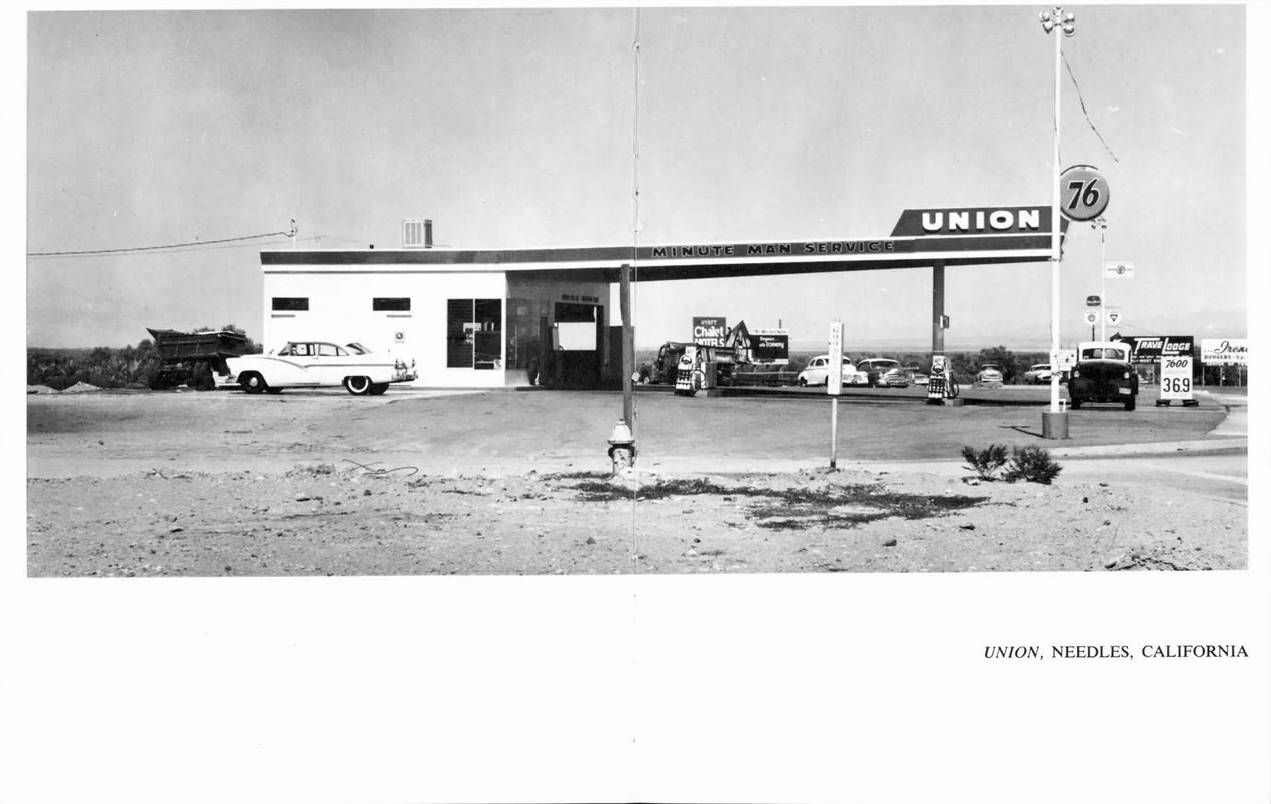
Its uniqueness
Route 66 wasn't the longest of America's U.S. Highway System (that honor went to U.S. 20), it didn't cross the continent like U.S. 6 did. However it was better known than any of the others. It was driven by millions during its 59 year lifespan (1926-1985), GIs, families on vacation, and they were bewitched by the road, with its wacky roadside attractions, the vastness of America, the changing natural setting (from the Ozarks to the high plains, to the Rocky Montains and the deserts in the Southwest).
Nowadays it evokes an era of certainty, stability, American values at their best, an era we all look back at with nostalgia.
So, pack your stuff, get into your car and head out on a road trip along famous Route 66. Enjoy the ride, and live your adventure!
Sponsored Content
>> Book your Hotel in California

Credits
Banner image: Hackberry General Store, Hackberry, Arizona by Perla Eichenblat

